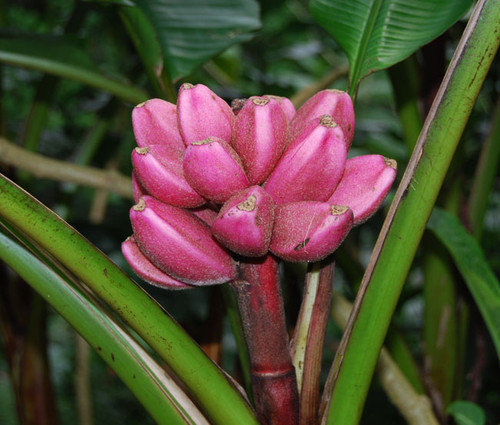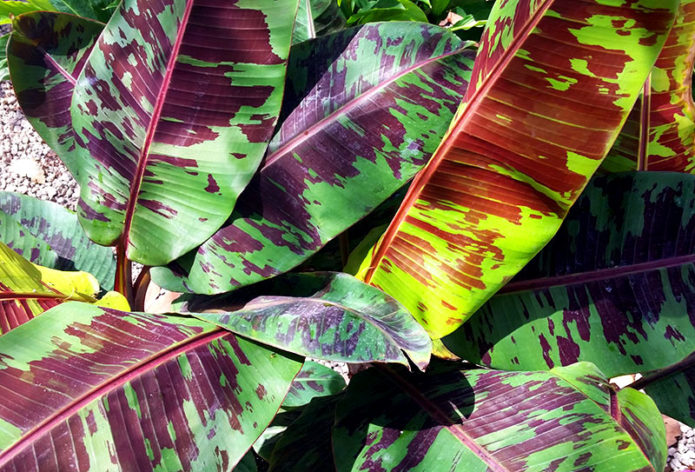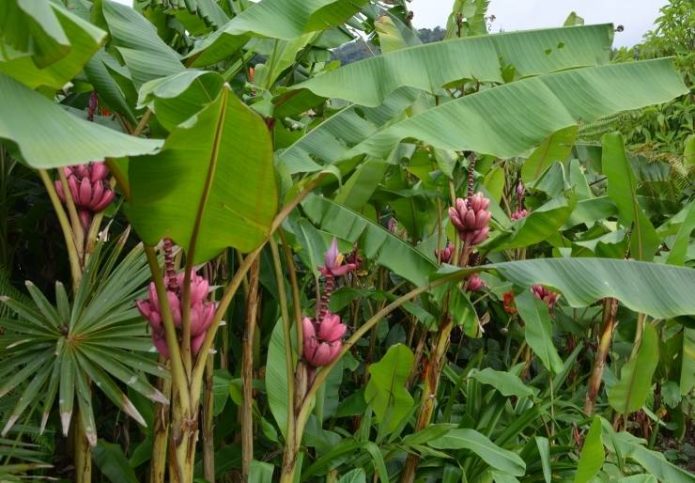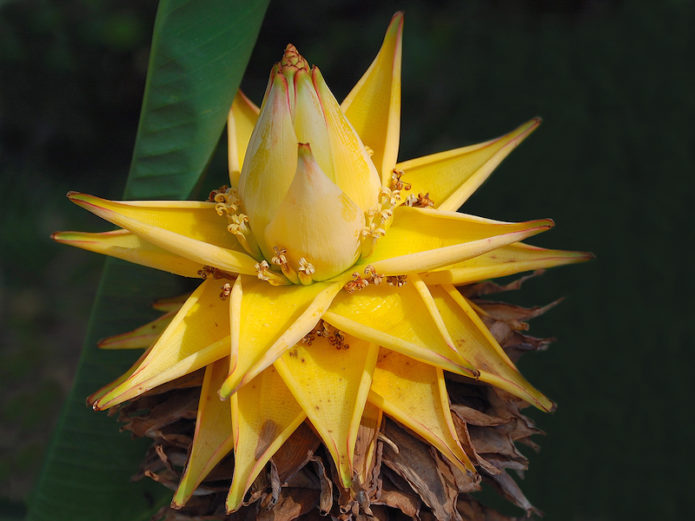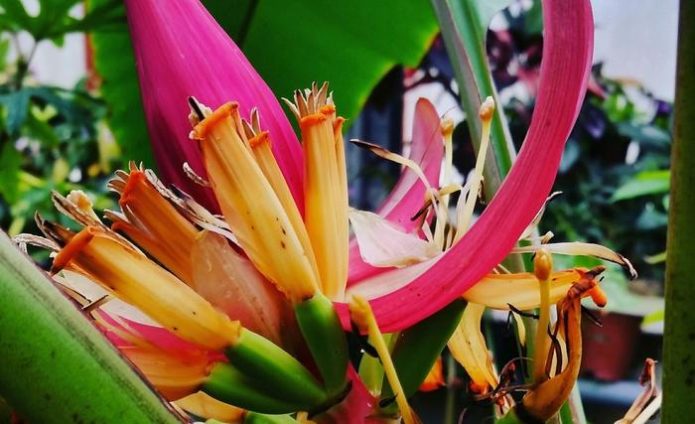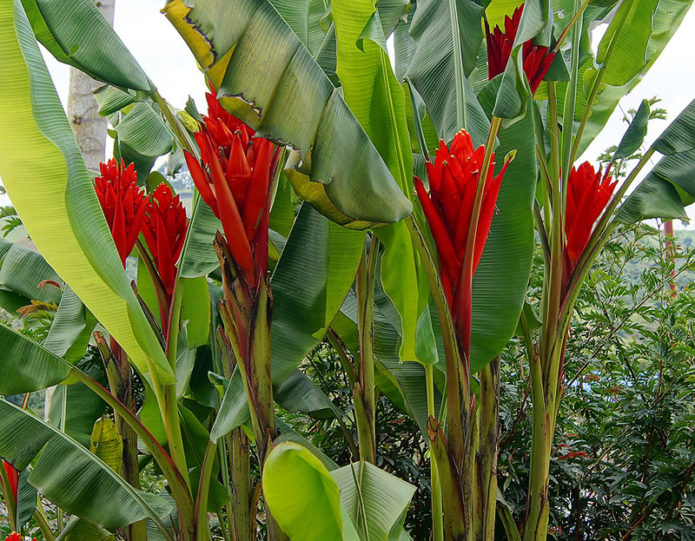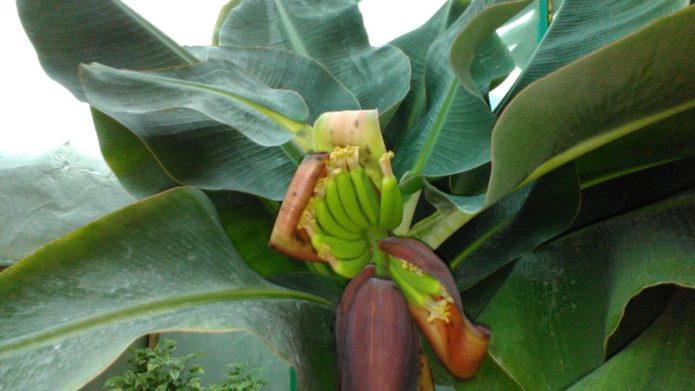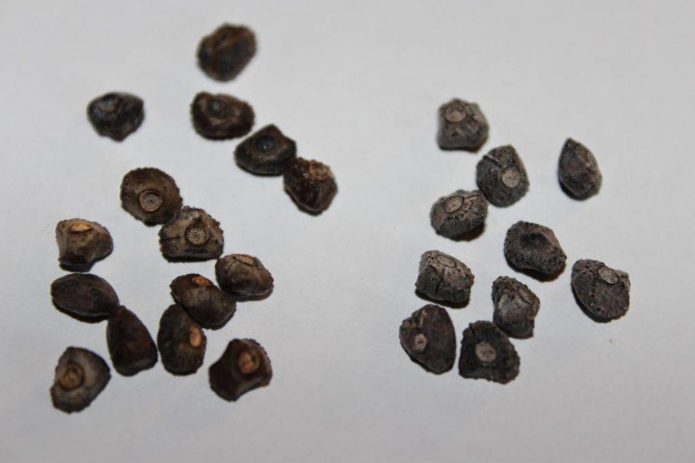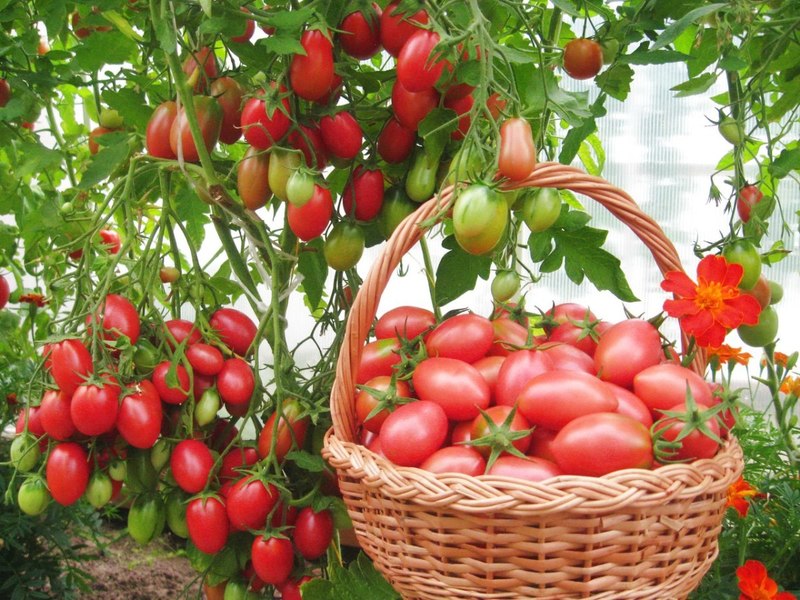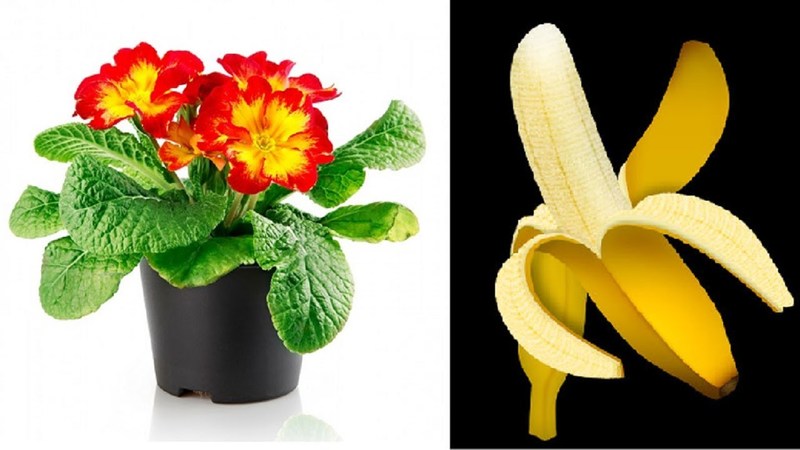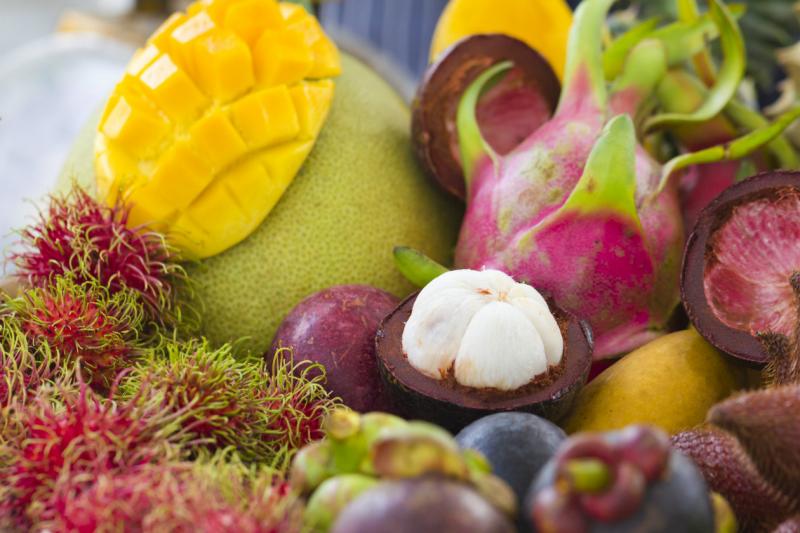It is believed that a banana is nothing more than a tall palm tree. This is the only herbaceous perennial plant from the Banana family. Its fruits are not fruits, but berries. The genus includes more than 60 different species that grow in tropical climates in Australia, Africa, Asia. Despite the thermophilicity of the culture, it is really possible to grow it at home - it is enough for a banana to create an appropriate microclimate and choose the right variety. And then you can enjoy the fruits or use the plant as a decoration.
Content
Features of growing a banana at home
The peculiarity of a banana is that its spherical trunk (rhizome) is hidden under the ground and serves as an alternative to the root... And on the surface you can see leaves tightly adjacent to each other, which is also called a pseudostem. From its center comes a peduncle with an inflorescence opening at the end. After flowering and fruiting, it dies off. And the rhizome continues to live and sprout out shoots (babies) that grow into a new plant.
In an apartment, a banana can be grown from seeds or you can buy a sprouted specimen. Only such plants will differ. Stronger representatives grow from seeds, but their fruits are inedible (inside they are clogged with seeds). Horticultural departments sell plant breeding varieties of bananas that are capable of vegetative propagation. Here they can please with delicious berries.
It is recommended to grow dwarf varieties in the house, since they are more unpretentious to conditions and resistant to diseases. They are compact and low (up to 1.5 m).
Indoor species and varieties: description and photo
Conventionally, all bananas are divided into two types: decorative and fruiting. The first option is intended solely for beauty due to its aesthetic appearance. Many of them bear fruit, but these bananas are not recommended.
Popular varieties of indoor bananas:
- Pink Banana (Musa Velutina) - grows up to 1 m in height. It begins to bloom in the second year of growth with miniature pink inflorescences. Its fruits are of the same color, collected in bunches of 8-9 pieces and stuffed with seeds.
- Bloody banana (Musa Zebrina) is a variety in which the outside of the leaf plates are bright green with red spots, and the inside is completely scarlet. The fruits are tasteless and outwardly unlike ordinary bananas.
- Banana purple, or lilac (Musa ornata, or Musa violacea) - blooms with real small bananas, dark red in color, but inedible.
- The yellow banana (Musella Lasiocarpa) is a short and slow growing specimen. Blossoms with spectacular yellow flowers. Its flowering period lasts about six months.
- Banana Mann (Musa Mannii) is an exclusively decorative representative. R This plant is no more than 1.2 m high.
- Scarlet Banana (Musa Coccinea) is an ornamental perennial with narrow long green leaves and bloody inflorescences. Blooms for about 2 months.
- "Kiev dwarf" (Musa super dwarf cavendish) is a versatile variety that, along with decorative large leaves covered with a waxy bloom and bright burgundy inflorescences, bears fruit with delicious bananas. It grows in height up to n1.5 m. The plant is cold-resistant and capable of blooming up to a year.
- "Super Dwarf Cavendish" - a hybrid up to 1.3 m high, with beautiful foliage and flowers. It also bears fruit, but enters this period more slowly than other varieties.
Conditions for keeping a banana in the house
Banana needs a lot of light for active growth and development.... Therefore, they place the culture on the southern windowsills, but create a slight shade from the midday heat, otherwise burns will appear on the leaves. Indoors, they try to maintain high humidity, or they spray the plant daily with warm, settled water. In spring and summer, it is recommended to take a banana out into the garden or on the balcony, only if there is no nightly cold snap.
When keeping a banana, sharp temperature jumps are unacceptable, which will lead to the death of the tree.
Table: optimal conditions for keeping
| Season | Humidity | Temperature | Lighting |
| Spring Summer | Increased - about 70% | + 23-29 ᵒС | As bright as possible |
| Autumn winter | + 17–20 ᵒС | Supplemented with fluorescent lamps to extend daylight hours up to 10-11 hours |
Planting and transplanting
When choosing a method for growing a banana from seeds, take into account that in the end only decorative varieties are obtained. For planting, seeds from wild-growing bananas, not those sold in grocery stores, are suitable. Mostly seed material is ordered online or purchased from specialized horticultural departments.
Purchased seeds are black, round and extremely hard. To improve their germination, it is necessary to pre-pierce the shell by cutting with a knife, soak in warm water for 2-3 days and place on a sunny windowsill. After the allotted time, the seeds are ready for planting. Meanwhile, the substrate is being prepared. You can buy ready-made (sphagnum, coconut) or mix peat yourself with coarse sand in a ratio of 1: 3. A container with sides is suitable, it should be up to 15 cm high.
Further actions:
- A drainage layer (expanded clay, brick chips or small stones) is laid out at the bottom of the container, then a soil mixture up to 6-7 cm thick.
- Seeds are distributed from above and pressed into the soil by 1 cm.
- After backfilling with earth, the crops are watered abundantly and covered with glass.
The first shoots hatch in 2–3 months.
If there is no desire to waste time on seed germination, then stop at the option of buying a banana seedling. At home, he is not bothered for 2-3 weeks to give him time to adapt to a new place. Then they are transplanted into a new pot. It should be of a larger volume than the previous one - about 6-7 liters. It is recommended to take soil for a banana tree from a deciduous forest, adding humus to it (proportions - 5: 1). For disinfection, it is calcined in an oven at a temperature of 60–70 ᵒС for 25 minutes or poured with boiling water.
Transplant technology:
- At the bottom of the container, expanded clay is poured as drainage (4–5 cm thick) and a handful of sand.
- Fill the pot with the prepared substrate, watered with settled water.
- Make a depression in the middle.
- The seedling is carefully removed, taking it along with a clod of earth. Install it exactly in the hole and bury it.
The plant is rearranged where there is no exposure to direct sunlight and draft. The optimum temperature for banana rooting is 24–30 ᵒС.
In the future, the banana is transplanted as needed, when the roots begin to break through the drainage holes. In the first years after planting, this is done often. For mature plants, one transplant every 2 years is enough.
How to grow a banana at home: care tips
Indoor banana crop care depends on the season. In spring and summer, the plant is in the growing season, and in autumn and winter it enters the dormant stage.
Watering
The banana is watered abundantly: in the summer - 2 times a day, in the winter - as the upper soil layer dries. The water is preliminarily defended at room temperature and poured into the pot until it begins to seep into the pan. From there it is immediately drained. Despite the moisture-loving culture, water stagnation is unacceptable. This leads to root rot and death of the plant.
To maintain high humidity, the plant is sprayed daily in summer, and in winter, once every 7 days. Systematically wipe the sheet plates with a damp cloth from dust.
Top dressing
Banana is actively fed during the spring-summer season - once a week, and with the arrival of a cold snap, the frequency is reduced to 1 time per month. This procedure is carried out immediately after watering, otherwise you can burn the rhizome. The following fertilizers are used:
- humus (no chicken or pork residues);
- biohumus;
- decoction of fish offal;
- herbal infusion of lupine, quinoa or any siderates.
They should be alternated. If you take humus or vermicompost, then adhere to the following dosages: 200 g per 1 liter of boiled water. The mixture is infused for a day and poured under the root of the plant. The herb infusion is prepared by combining 200 g of crushed raw materials and 1 liter of boiling water. The remedy is insisted for a day and used as directed.
Fish dressing recipe:
- Fish waste in the amount of 250 g is immersed in water (2 l) and brought to a boil.
- Boil for half an hour.
- Dilute the ear with cool water twice and filter.
This solution is recommended to be used in combination with humus or vermicompost.
How to make a banana bloom
Banana is a fast-growing species and begins to bloom after 12-15 leaves have formed. To speed up this process, follow the recommendations of the professionals:
- they are fed with fertilizers with a high content of potassium and phosphorus;
- do not touch the baby on the plant if it is in a single copy;
- a young tree is planted next to an adult tree, which will become a replacement after the death of the "parent".
Dormant period
During the wintering of a banana, the room temperature should not drop below +10 ° C. If it drops to zero, then the plant will inevitably die. Shortly before the onset of winter, the banana leaves are pruned and transferred to a place where it is cool and light. Do not place the plant near batteries.
Table: common mistakes in care, consequences and ways to correct them
| Painful manifestations | Causes | Correction methods |
| Inhibited growth and leaf decay | Lack of nutritional components | The plant is additionally fed and transplanted into a new pot, larger in volume |
| Curling and yellowing tips on leaves | Dry air | The damaged leaves are removed. More often they spray the crown and increase the humidity in the room by installing a special device or a container with water |
| The foliage loses its rich color, becomes smaller | Insufficient lighting | Rearranged in a brighter place, illuminated with lamps in winter |
| Leaves become soft and droop | Reduced room temperature | Change the location of the tree so that there is no draft |
| Dark spots appear between the veins on old leaf plates | Common occurrence | Do nothing |
| With the onset of spring, the plant did not come out of dormancy. | Insufficient nutrition | Make top dressing |
| The stem darkens below and loses its elasticity | Excessive moisture | Reduces the number of waterings |
Diseases and pests
Bananas have strong immunity, so it is unusual for them to get sick often. The only thing that threatens the plant is root rot, which occurs against the background of excessive watering.
In this case, the tree is dug up, the damaged areas are cut from the stem and sprinkled with ashes. Then transplanted into a fresh substrate. In the future, they adhere to the standard rule - do not allow long stagnation of water in the sump.
If the leaves on young plants lighten a lot or acquire an unnatural yellowness, then this is chlorosis. The disease develops due to iron deficiency. The tree is transplanted into a fertile substrate with a slightly acidic alkaline medium, watered with lemon water (5-6 drops of lemon juice per 1 liter). Additionally, complex iron-containing fertilizers are applied.
Indoor banana varieties are susceptible to spider mites... The risk increases when the plant is in a low humidity environment. They get rid of pests by treatment with the insecticidal preparation "Aktara" (instructions for use are written on the package).
Reproduction
Home banana propagates vegetatively - by shoots (children)... They form on the bulb-rhizome as the plant grows. The procedure is carried out only after the completion of fruiting and the exit of the culture from dormancy - in the spring. You cannot tear off all the offspring at once so that the banana does not die.
They act according to the following algorithm:
- Cut off the process along with the root. It should have 3-4 developed leaves.
- Sections are treated with ash.
- They are planted in a separate pot filled with soil, as for an adult plant.
For successful germination, it is necessary to create a temperature regime within 22–30 ° C, provide good lighting and high humidity (up to 90%).
Growing a banana tree is an interesting process, but not an easy one. If you adhere to the standard recommendations for care and conditions of detention, then success is guaranteed. It is important to choose the right seeds or buy a healthy seedling.

